This was published 5 years ago
Jose Cuervo Express train ride to Tequila: The real story behind Mexico's famous drink
By Kerry van der Jagt
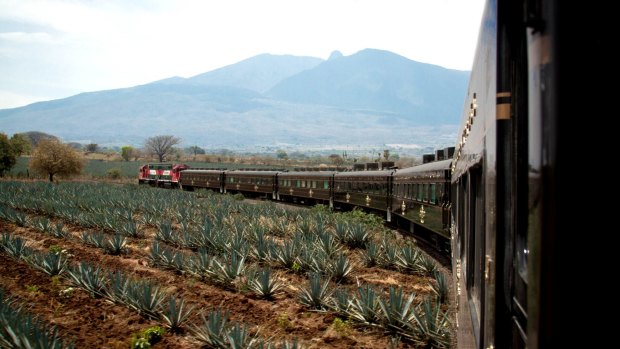
The Jose Cuervo Express.
My foray into tequila appreciation began on a train with 400 drunken Rabbit Gods and ended with a headache as throbbing as a Mexican hat dance.
And that was just the first day.
It's 8.30am when we board the luxurious Jose Cuervo Express in Guadalajara for the two-hour journey to Tequila in the western state of Jalisco, the birthplace of the namesake spirit. I've dressed up for the occasion, wearing an off-the-shoulder top and a pair of tapered black pants, perfect for this journey back in time through Mexico's heartland.
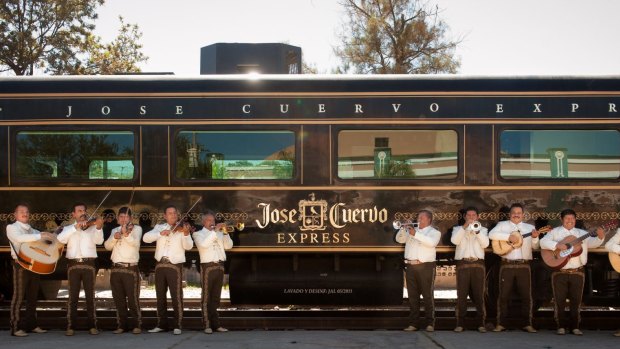
The Jose Cuervo Express to Tequila.Credit: Mundo Cuervo
"Would you like your margarita frozen or over ice?" asks waiter Fernandez, as I step on board.
Long relegated as the drink of wild nights and dreadful mornings I'm on the tequila trail for two reasons – to learn about the spirit's history, and to use it as a conduit for connecting more deeply with a culture that can be hard to break into.
The taste for tequila began with the Aztecs, who had long produced a fermented drink made from the sap of the agave plant known as pulque. According to Aztec mythology the 400 Drunken Rabbit Gods were the love bunnies of Mayahuel the Goddess of Alcohol and Patecatl the God of Medicine.
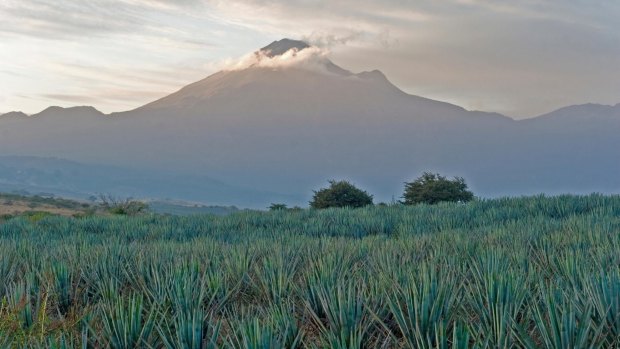
Agave field, Tequila.Credit: Alamy
Raised on the alcoholic sap that flowed from their mama's 400 breasts, these bunnies, collectively known as Centzon Totochtin, represent the various stages of drunkenness. Standouts include the Five Rabbit God of Alcoholic Beverages (otherwise known as the God of Headaches and Hangovers), The Winged One (Yes, I can fly!) and the God of Hanging (Urgh, I'm going to die). I'm not exactly sure of the translation, but I know I've met these characters before.
It was the Spaniards who took the potent punch a step further in 1758 when Jose Antonio de Cuervo was awarded a land grant by the King of Spain to grow agave for tequila production. Today the spirit is protected by the Mexican government under an Appellation of Origin Tequila, like champagne or Cognac, and can only be produced from the blue agave plant – Agave Tequilana Weber – grown in this region and a few other limited areas.
For now the divine rabbits are quiet as I settle into my plush seat in "Premium Plus", the highest category of carriage, complete with pressed metal ceilings, wood panelling, personal waiters and a private bar serving premium Jose Cuervo tequilas and other spirits. Mexican snacks and margaritas are plentiful as the sprawling city gives way to a sea of blue agave fields, the train's carriages bending through the succulents like the spine of a mythical creature.
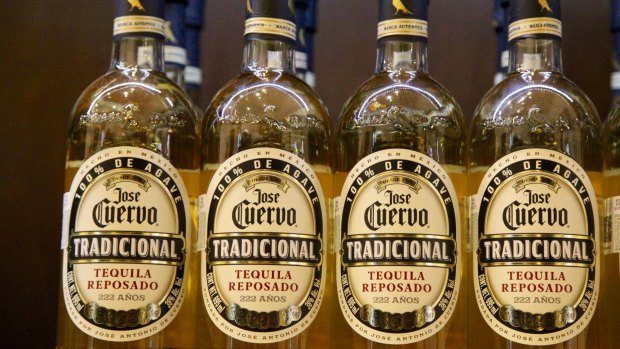
History in a bottle.Credit: Kerry van der Jagt
After a traditional margarita I switch to a strawberry version, a flamingo-pink concoction with a hint of chilli, seemingly favoured by the younger crowd. Raising my glass I can almost hear Bugs Bunny urging me on, "Well, it's five o'clock somewhere folks".
I'm a little light-headed as we commence the serious business of tequila tasting, progressing from blanco to reposado (rested) to anejo (aged). Thankfully 100 per cent blue agave tequila is made for sipping and savouring, and not for doing shots. Nor is the vile salt and lime needed to mask the flavour. Instead, dark chocolate, coconut or agave strips are sniffed and nibbled between tastings.
Tequila (the town) arrives in a blaze of colour; stucco buildings in pink, tangerine and aqua; fountains with canary yellow tiles; tacos and textiles on every corner, all set around a central plaza and overlooked by the brooding (but extinct) Tequila Volcano. All up the town boasts 22 tequila houses, many of which are open for tours and tastings, but 11 generations later, Jose Cuervo is still the biggest player in town.
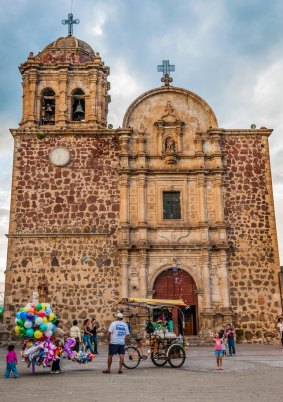
A cathedral in the town of Tequila, Jalisco, Mexico.Credit: Alamy
While the majority of passengers set off to tour Jose Cuervo's La Rojena distillery, I collect my luggage and check in to Hotel Solar de las Animas, a luxury hotel alongside the 17th century church Parroquia Santiago Apostol. Part of Mundo Cuervo, the hospitality branch of the family-owned Jose Cuervo, the 93-room hotel allows for full immersion into the world of tequila, albeit with a soft landing – think rooftop pool, day spa and sky bar with views across to the volcano.
I spend the remainder of the day roaming the cobbled streets, snacking on fresh corn, shopping at markets and ducking in and out of shady courtyards. On one shortcut I stumble upon a wedding, complete with horse-drawn carriage and pastel confetti falling like rose petals.
It's easy to see why the town was declared a Pueblos Magicos, one of Mexico's "Magic Towns" celebrated for its mix of historical, cultural and aesthetic qualities. To add to its accolades the town's ancient industrial facilities and agave landscape are listed as a cultural UNESCO World Heritage site.
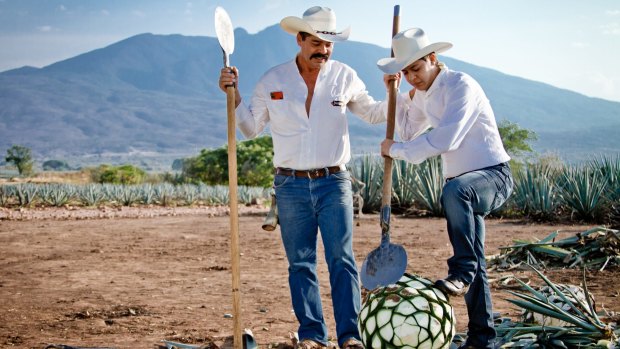
Tequila jimadors in the agave field.
Dinner is a three-course affair at restaurant La Antigua Casona in the Hotel Solar de las Animas, where even the meals have a tequila flavour, from the mixed salad with an agave dressing to a grilled flank steak with potatoes and tequila sauce. Not a gimmick, just a creative chef making good use of local products.
The following morning I join an in-depth tour of the agave fields on the outskirts of town, stopping to watch a demonstration by a skilled jimador, or agave harvester. "It takes about 10 years until they are ready," explains our guide Alfredo Quezada, as the jimador slashes at the fronds of the blue plant to reveal the pineapple-like heart. Known as the pina, each heart weighs an average of 35 kilograms. "With a yield of one litre of tequila for every seven kilos of pina you can see how productive it is."
On horseback we push deeper into the fields, my quarter horse Hurricane throwing up pieces of flinty rock, a reminder of the hulking volcano in the distance and the very reason the blue agave plant flourishes in this rich soil.
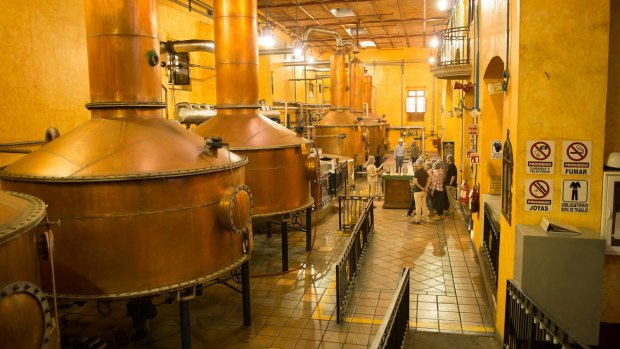
Jose Cuervo's La Rojena distillery.
Riding between the rows, which shimmer in the haze like an ocean of seagrass, we learn that the word tequila comes from the Aztec language and translates as "the place where you can cut", a reference to the sharp volcanic obsidian once used to make tools. "To the Aztecs the sharp fronds of the agave plant pointing to the sky were a constant reminder of the many gifts from the gods," says Alfredo.
Back in Tequila we tour La Rojena distillery, the oldest commercial tequila producer in the world. "Unlike other operators Jose Cuervo still uses traditional stone kilns to roast the agave, not stainless steel autoclaves," explains Alfredo.
The tour leads us through the various stages of baking, milling, squeezing, fermenting and distilling. Walking between the oak barrels Alfredo regales us with stories of the secret tunnels that run under the city connecting the church with the cellars, a sneaky escape hatch used during the 1920s when Catholic priests were persecuted across central-west Mexico. Either that, or the priests simply enjoyed a drink.
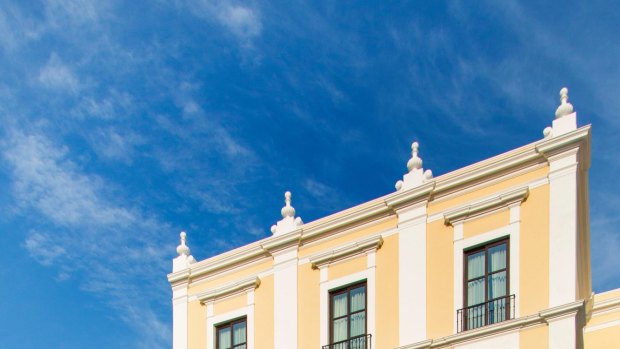
Solar de las Animas Hotel, Tequila, Jalisco, Mexico.Credit: Alamy
By nightfall I've forgotten my resolution of no more tequila for the day, queuing with locals in the square for the traditional tipple known as cantarito. Served in heavy clay cups the drink is a refreshing blend of tequila, lime juice, chunks of orange and grapefruit, ice and salt.
When a drink is this good it's not long before Techalotl shows up, the rabbit God of Dance, drawing a few old timers to their feet as a mariachi band takes to the square. I sit tapping my foot, until the church bells chime at 9pm sharp, the time when the folk of Tequila rise to their feet to receive a blessing from the priest. It seems, even centuries later, the Gift from the Gods is still being revered in Tequila.
FIVE OTHER THINGS TO DO IN TEQUILA
1.HIKE THE TEQUILA VOLCANO
At 2940 metres, the hike to the summit is 18 kilometres, most of it along a cobblestone road.
2.VISIT THE NATIONAL MUSEUM OF TEQUILA
Set in an old colonial building this small museum tells the tequila tale from pre-Hispanic times to present. See mexicoescultura.com
3. TAKE A TEQUILA BLENDING MASTERCLASS
Learn about the five main types of tequila, then blend your own according to preference. See mundocuervo.com
4.ENJOY A DRINK AT LA CAPILLA (THE CHAPEL)
Said to be the oldest bar in town, this is where the infamous Batanga cocktail was created in 1961. Calle Miguel Hidalgo 31, Tequila
5.VISIT THE CASCADES LOS AZULES (BLUE WATERFALLS)
Located a 15-minute drive from Tequila overlooking the La Toma Valley. See visitmexico.com
TRIP NOTES
MORE
TRAVEL
United Airlines flies daily nonstop from Sydney to Houston, with onward connections to Guadalajara. Melbourne passengers can either travel to Sydney or fly to Los Angeles for onward connections. See unitedairlines.com
The Jose Cuervo Express departs Guadalajara every Saturday morning for the journey to Tequila. "Premium Plus" costs $US128.77 a person one way including a professional tasting, snacks, premium cocktails, Mexican show and tours of La Rojena distillery and Reserva de la Familiar cellar. See mundocuervo.com/eng/jose-cuervo-express
STAY
Rooms at the luxurious Hotel Solar de las Animas start from $US220 plus taxes a night, double occupancy. See hotelsolardelasanimas.com
TOUR
A range of exclusive experiences, including a tequila blending masterclass and horseback riding through the agave fields, can be organised through hotelsolardelasanimas.com/hotel-contacts.html
Kerry van der Jagt travelled as a guest of Mundo Cuervo and United Airlines
See also: The truth about where Bacardi comes from
Sign up for the Traveller Deals newsletter
Get exclusive travel deals delivered straight to your inbox. Sign up now.